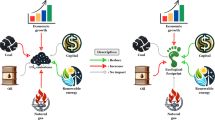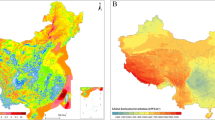Abstract
Carbon emissions in the power sector are an important part of China’s total carbon emissions and have a significant impact on whether China can achieve the 2030 carbon peak target. Based on the three perspectives of decomposition, decoupling, and prediction, this paper studies the feasibility of carbon emission peaks in eight major regional power sectors in China. First, the generalized Divisia index model (GDIM) is used to decompose the carbon emissions of the eight regional power sectors, and the driving factors and their effects on carbon emissions in the power sector of each region are compared. Then, the decoupling index based on the generalized Divisia index model (GDIM-D) is used to study the decoupling relationship between the carbon emissions of the eight regional power sectors and economic growth. Finally, the carbon emissions and decoupling indices of the power sector from 2017 to 2030 are predicted. The results show the following. First, the gross domestic product (GDP) and output scale are the main factors contributing to the carbon emissions of the eight regional power sectors. The carbon intensity of the power sector in GDP (C/G) and output carbon intensity(C/E) are the main factors that contribute to the reduction. Second, the carbon emissions of the southern coast, the middle Yellow River, and the Southwest peaked in 2013 and have been decoupled from economic growth, while those in the other regions have not peaked or decoupled. Third, if the carbon emissions of the power sector in the Northeast, northern coast, eastern coast, middle Yangtze River, and Northwest reach a peak in 2030, they will face many emission reduction pressures. This paper provides a reference for studying the carbon emissions of China’s regional power sectors and their relationship with economic growth and has important implications for peak carbon emissions at the national level.






Similar content being viewed by others
References
Ali H, Sanjaya S, Suryadi B, Weller SR (2017) Analysing CO2 emissions from Singapore’s electricity generation sector: Strategies for 2020 and beyond. Energy 124:553–564
Ang BW, Goh T (2016) Carbon intensity of electricity in ASEAN: drivers, performance and outlook. Energy Policy 98:170–179
Bai C-G, Shi B-F, Liu F, Sarkis J (2019) Banking credit worthiness: evaluating the complex relationships. Omega 83:26–38
Chai N-N, Wu B, Yang W-W, Shi B-F (2019) A multicriteria approach for modeling small enterprise credit rating: evidence from China [J]. Emerg Mark Financ Trade 55(11):2523–2543
Chen X, Guo W, Tang R-H (2018) The huge pressure of low-carbon development in the power industry and t carbon trading tips for power generation groups. Polaris Power Web (in Chinese)
China and America (2014) Joint U.S.-China Statement on climate change.
China Electricity Council (2016) Annual national electricity supply and demand situation analysis and forecast report in 2016(in Chinese)
Collins S, Saygin D, Deane JP, Miketa A, Gutierrez L, Ó Gallachóir B, Gielen D (2018) Planning the European power sector transformation: the REmap modelling framework and its insights. Energ Strat Rev 22:147–165
Diakoulaki D, Mandaraka M (2007) Decomposition analysis for assessing the progress in decoupling industrial growth from CO2 emissions in the EU manufacturing sector. Energy Econ 29:636–664
Emodi NV, Chaiechi T, Alam Beg ABMR (2019) Are emission reduction policies effective under climate change conditions? A backcasting and exploratory scenario approach using the LEAP-OSeMOSYS Model. Appl Energy 236:1183–1217
Engo J (2018) Decomposing the decoupling of CO2 emissions from economic growth in Cameroon. Environ Sci Pollut Res Int 25:35451–35463
GCP (2018), Global Carbon Budget 2018.
Guo W-B, Chen Y (2018) Assessing the efficiency of China’s environmental regulation on carbon emissions based on Tapio decoupling models and GMM models. Energy Rep 4:713–723
Han H, Zhong Z, Guo Y, Xi F, Liu S (2018) Coupling and decoupling effects of agricultural carbon emissions in China and their driving factors. Environ Sci Pollut Res Int 25:25280–25293
IFCE (2016) 2016 Clean Energy Blue Book (in Chinese)
Jiang X-T, Li R (2017) Decoupling and decomposition analysis of carbon emissions from electric output in the United States. Sustainability 9:886
Li H, Qin Q (2019) Challenges for China’s carbon emissions peaking in 2030: a decomposition and decoupling analysis. J Clean Prod 207:857–865
Li W, Zhang Y-W, Lu C (2018a) The impact on electric power industry under the implementation of national carbon trading market in China: a dynamic CGE analysis. J Clean Prod 200:511–523
Li X, Liao H, Du Y-F, Wang C, Wang J-W, Liu Y (2018b) Carbon dioxide emissions from the electricity sector in major countries: a decomposition analysis. Environ Sci Pollut Res Int 25:6814–6825
Liu Q, Tian C, Deng X-Q, Chen Y (2017) Evaluation of policies related to carbon emission reduction in China’s power industry. Resour Sci 39(12):2368–2376 (in Chinese)
Liu Q, Zheng X-Q, Zhao X-C, Chen Y, Lugovoy O (2018) Carbon emission scenarios of China's power sector: impact of controlling measures and carbon pricing mechanism. Adv Clim Chang Res 9:27–33
Liu Y-Y, Wang Y-Q, Li D, Yu Q (2019) Life cycle assessment for carbon dioxide emissions from freeway construction in mountainous area: primary source, cut-off determination of system boundary. Resour Conserv Recycl 140:36–44
Marques AC, Fuinhas JA, Leal PA (2018) The impact of economic growth on CO2 emissions in Australia: the environmental Kuznets curve and the decoupling index. Environ Sci Pollut Res Int 25:27283–27296
Meng M, Jing K, Mander S (2017) Scenario analysis of CO2 emissions from China’s electric power industry. J Clean Prod 142:3101–3108
National Development and Reform Commission (2013) China's power generation enterprises greenhouse gas emissions accounting methods and reporting guidelines (Trial) (in Chinese)
National School of Development at Peking University (2017) New source of China’s economic growth (Volume 1): reform, resources, energy and climate change (in Chinese)
Özer B, Görgün E, İncecik S (2013) The scenario analysis on CO2 emission mitigation potential in the Turkish electricity sector: 2006–2030. Energy 49:395–403
Pan W, Li K-J, Teng Y (2018) Rethinking system boundaries of the life cycle carbon emissions of buildings. Renew Sust Energ Rev 90:379–390
Pleßmann G, Blechinger P (2017) How to meet EU GHG emission reduction targets? A model based decarbonization pathway for Europe’s electricity supply system until 2050. Energ Strat Rev 15:19–32
Sheng L Y et al. (2004-2017) China Statistical Yearbook. China
Shi B-F, Zhao X, Wu B, Dong Y-Z (2019) Credit rating and microfinance lending decisions based on loss given default (LGD). Financ Res Lett 30:124–129
Tang B-J, Li R (2016) Research on carbon emission characteristics of Beijing power sector based on LMDI model. China Energy 38(03):38–43
Tang B, Li R, Yu B, An R, Wei Y-M (2018) How to peak carbon emissions in China’s power sector: a regional perspective. Energy Policy 120:365–381
The State Council (2016) Notice of the 13th five-year plan for controlling greenhouse gas emissions (in Chinese)
The State Council (2006) Strategies and policies for regional coordinated development (in Chinese)
Vaninsky A (2014) Factorial decomposition of CO2 emissions: a generalized Divisia index approach. Energy Econ 45:389–400
Wang Y-H, Xie T-Y, Yang S-L (2017) Carbon emission and its decoupling research of transportation in Jiangsu Province. J Clean Prod 142:907–914
Wang Y-N, Li X-B, Kang Y-Q, Chen W, Zhao MJ, Li W (2019) Analyzing the impact of urbanization quality on CO2 emissions: what can geographically weighted regression tell us? Renew Sust Energ Rev 104:127–236
Wei S-F, Zhou X-Q et al. (2004-2007) China Power Yearbook. China
Wen J-W, Geng Q, Xu X-C, Xu Y-F et al. (2004-2017) China Energy Statistics Yearbook. China
Wu Y, Chau K-W, Lu W, Shen L, Shuai C, Chen J (2018) Decoupling relationship between economic output and carbon emission in the Chinese construction industry. Environ Impact Assess Rev 71:60–69
Yu L, Li Y-P, Huang G-H, Li Y-F, Nie S (2016) Planning carbon dioxide mitigation of Qingdao’s electric power systems under dual uncertainties. J Clean Prod 139:473–487
Yuan L, Pan J-H (2013) The Decomposition of carbon emission driver by using Kaya identity and the limitations of its policy implications. Res Progr Clim Change 9(3):210–215 (in Chinese)
Zhang A-M, Wang M-N (2016) Research on the driving factors and paths of China’s carbon emission reduction. Hebei Acad J 36(6):214–218 (in Chinese)
Zhang Y-J, Da Y-B (2015) The decomposition of energy-related carbon emission and its decoupling with economic growth in China. Renew Sust Energ Rev 41:1255–1266
Zhao Y, Li H, Zhang Z, Zhang Y, Wang S, Liu Y (2016) Decomposition and scenario analysis of CO2 emissions in China’s power industry: based on LMDI method. Nat Hazards 86:645–668
Zhu L, He L, Shang P, Zhang Y, Ma X (2018) Influencing factors and scenario forecasts of carbon emissions of the Chinese power industry: based on a generalized Divisia index model and Monte Carlo simulation. Energies 11:2398
Zu G-H, Ma X-C, Yang L-L (2010) Scenario analysis of carbon emission of electric energy consumption based on Divisia index decomposition method. Hydropower Energy Sci 11:166–168
Funding
This paper is supported by the Youth Research Program in Humanities and Social Sciences, Ministry of Education (18YJC910013), National Social Science Fund (19CTJ008), Liaoning Province Financial Scientific Research Fund Project (18B010), the National Natural Science Foundation of China (71573034), Liaoning Social Science Fund (L17CTJ001, L17BJY042), and the Research Project of Dongbei University of Finance and Economics (DUFE2017Q16).
Author information
Authors and Affiliations
Contributions
Yong Wang and Xuelian Su were mainly responsible for the writing of the full text. Yonghong Xu conceived and designed the study. Lin Qi and Peipei Shang built the models of the paper.
Corresponding author
Ethics declarations
Conflicts of Interest
The authors declare that they have no conflict of interest.
Additional information
Responsible editor: Philippe Garrigues
Publisher’s note
Springer Nature remains neutral with regard to jurisdictional claims in published maps and institutional affiliations.
Appendix
Appendix
Rights and permissions
About this article
Cite this article
Wang, Y., Su, X., Qi, L. et al. Feasibility of peaking carbon emissions of the power sector in China’s eight regions: decomposition, decoupling, and prediction analysis. Environ Sci Pollut Res 26, 29212–29233 (2019). https://doi.org/10.1007/s11356-019-05909-1
Received:
Accepted:
Published:
Issue Date:
DOI: https://doi.org/10.1007/s11356-019-05909-1








